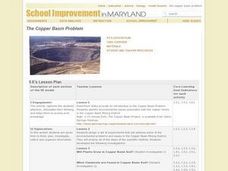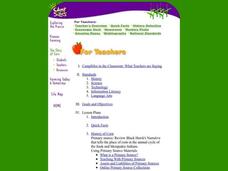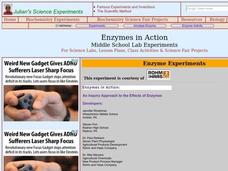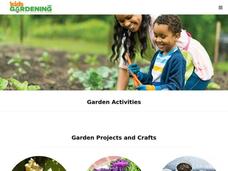Curated OER
Soil pH Effect on Germination of Specific Weeds
Students collect weed seeds from three varieties of weeds (knapweed, thistle, or toadflax, for example they may choose others in addition to the spotted knapweed.) They sterilize soil for thirty containers, plant seeds in sterile soil,...
Curated OER
Antebellum North Carolina
Eighth graders examine pictures & documents relating to the Hayes Plantation (Edenton, NC). They also use various maps of North Carolina to help them analyze how James Cathcart Johnston used, modified and adapted to the physical...
Curated OER
Yeast: A Dihybrid Cross
Students create a yeast dihybrid cross and follow two forms of each of two traits: red growth versus cream color, and tryptophan-dependent versus tryptophan-independent. They complete diagrams to represent the alleles, predict the...
Curated OER
Building a Terrarium System
Young scholars create their own terrariums. In this ecological model instructional activity, students create terrariums using soil, seeds, pebbles, and two liter bottles. Young scholars compare the elements of a...
Curated OER
What Goes Around Comes Around!
Learners create an ecosystem in a jar to show a model of the water, carbon, and nitrogen cycle. Working in small groups, they research and present orally the information they find on this cycle.
Curated OER
Alphabet Letter a Or N Theme
Students draw a tree with acorns. They depict roots and an acorn in the soil to review plant growth and practice handwriting letter A or letter N in the writing lines. They cut an additional page for the mini-book to include the word...
Curated OER
The Copper Basin Problem
Students view a video about how human actions impact the environment. They design a set of experiments to address some of the problems and issues raised by the video.
Curated OER
Botanical Garden Field Trip
Students take a field trip to a botanical garden. In this habitat lesson, students walk through the garden and see various species of plants and animals. Students take a canopy walk and see coniferous trees. Students write about what...
Curated OER
Oklahoma Grown: Discovering Oklahoma's Agriculture
Fourth graders investigate where Oklahoma's variety of crops are harvested, and grown their own plants. A printable map and crop information guide are provided.
Curated OER
Function of a Stem
Fourth graders perform an experiment to test the function of a stem. In this science instructional activity, 4th graders write a description of their investigations. Students also explain how the stem interacts with the rest of the...
Curated OER
The Story of Corn
Students use primary sources to compare the early development of corn with current techniques of biotechnology and genetically engineered seeds, and identify plants natural to the Americas and those natural to Europe that were part of...
Curated OER
Landforms
Students study how landforms affect all aspects of a community. Students work in groups to identify landforms from other works of art. In cooperative groups Students select a work of art depicting a particular land form and create a poem.
Curated OER
Fruit or Vegetable?
Watermelon is a vegetable? A tomato is a fruit? Believe it or not, this debate is decades old. Groups examine rulings by the US Supreme Court, the USDA, and state statutes before developing their own criteria to use when labeling...
Curated OER
This I Can Do: The Drive
Students read The Garden of Happiness and discuss the importance of the common good in a community. In this common good lesson, students understand how overcoming diversity and working together for a neighborhood drive. Students create a...
Curated OER
Enzymes in Action
Students explore how enzymes are important in the chemical reactions of all living things. In this enzymes and catalysts activity students complete an activity to see how enzymes change living things.
Curated OER
Bats and Boas Abound
Learners investigate Puerto Rican boa constrictors and bats. In this animal science lesson, students read an article about the bats and snakes found in Puerto Rico. Learners use various art supplies to create a diorama of the habitat of...
Curated OER
Food Chain: what's for dinner?
Fourth graders identify where foods came from and sequence a food chain. In this food chain lesson, 4th graders define vocabulary related to food chains and order a food chain. Students follow the energy of a food chain. Students...
Curated OER
Lesson 12: Ho'olaulima: Let's Make a Hawaiian Garden
Second graders grow a classroom garden that acts as a living laboratory for cross-curricular activities. In this classroom garden lesson, 2nd graders follow directions to build and plant a garden that is used to teach math, science, and...
Curated OER
Design, Grow, and Ponder in a Garden
A garden can inspire students to make mathematical connections.
Curated OER
What is Genetics?
In this biology worksheet, 9th graders identify which seed color is dominant in the given chart and explain why it is. Then they create a Punnett square showing the alleles of the parent plants and first generation of offspring.
Curated OER
Is Purple Loosestrife a Problem Near Our School?
Students explore to investigate if the distribution of Purple loosestrife around the school district area is relevant to its distribution and control. They create a comprehensive map to support their thesis and data and then head out...
Curated OER
Growing and Harvesting Fruits and Vegetables
Students learn the various parts of a farm and what is grown on a farm. They also match fruits and vegetables to locations where they are grown.
Curated OER
Making Paper
Students read about the history of paper production and make their own recycled paper. In this paper making lesson, students follow the directions to make paper from recycled paper. Students also learn about making paper from live plants.
Curated OER
Let's Sort a Salad
Students examine edible plants by identifying salad ingredients. In this botany instructional activity, students discuss the different vegetables that can be eaten in a salad and draw them on a worksheet. Students review vegetable...























